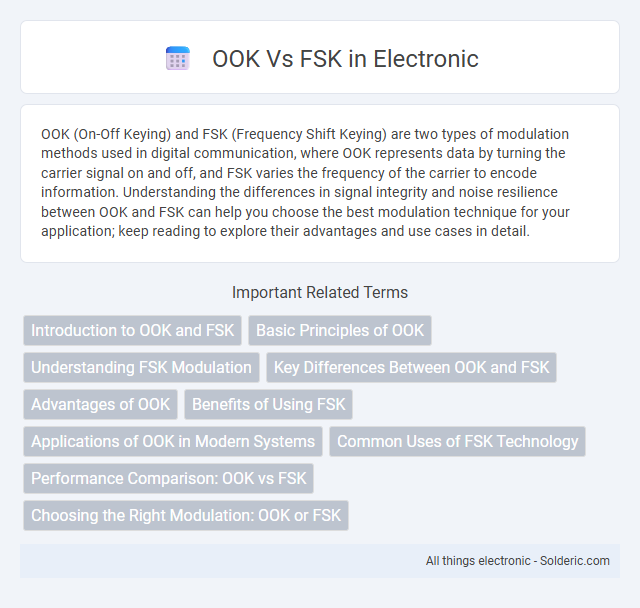OOK (On-Off Keying) and FSK (Frequency Shift Keying) are two types of modulation methods used in digital communication, where OOK represents data by turning the carrier signal on and off, and FSK varies the frequency of the carrier to encode information. Understanding the differences in signal integrity and noise resilience between OOK and FSK can help you choose the best modulation technique for your application; keep reading to explore their advantages and use cases in detail.
Comparison Table
| Feature | OOK (On-Off Keying) | FSK (Frequency Shift Keying) |
|---|---|---|
| Modulation Type | Amplitude modulation | Frequency modulation |
| Signal Representation | Presence or absence of carrier wave | Discrete frequency changes for binary data |
| Power Efficiency | Lower; power wasted in signal OFF states | Higher; continuous carrier signal |
| Noise Immunity | Lower; susceptible to amplitude noise | Higher; less affected by amplitude noise |
| Bandwidth Usage | Lower bandwidth but less efficient in noisy environments | Higher bandwidth due to frequency variation |
| Implementation Complexity | Simple and cost-effective | More complex transmitter and receiver design |
| Common Applications | Low-cost RF remote controls, simple data links | Modems, telemetry, radio communications |
Introduction to OOK and FSK
OOK (On-Off Keying) and FSK (Frequency Shift Keying) are fundamental modulation techniques used in digital communication systems. OOK transmits data by switching the carrier signal on and off, representing binary digits through the presence or absence of a signal, making it simple and power-efficient. FSK conveys information by varying the carrier frequency between predetermined levels for binary signals, offering better noise immunity and reliability in fluctuating channel conditions.
Basic Principles of OOK
On-off keying (OOK) transmits data by switching the carrier signal on and off to represent binary states, where the presence of a carrier wave denotes a binary '1' and its absence signifies a binary '0'. OOK modulation is a form of amplitude-shift keying (ASK) that uses simple binary amplitude levels for encoding information. Its basic principle relies on toggling the signal amplitude between zero and a fixed level, enabling straightforward implementation and efficient bandwidth usage in low-data-rate communication systems.
Understanding FSK Modulation
Frequency Shift Keying (FSK) modulation transmits digital information by varying the frequency of a carrier wave, switching between predefined frequencies to represent binary data. Unlike On-Off Keying (OOK), which modulates amplitude, FSK offers greater resistance to noise and improved signal integrity in wireless communication. This makes FSK ideal for applications requiring reliable data transmission, such as low-power RF devices and Bluetooth protocols.
Key Differences Between OOK and FSK
OOK (On-Off Keying) modulates data by switching the carrier signal on and off, representing binary states with presence or absence of a signal; FSK (Frequency Shift Keying) encodes data by shifting the carrier frequency between predefined values to indicate binary digits. OOK is simpler and requires less bandwidth, making it suitable for low-data-rate applications, while FSK provides better noise immunity and performance in noisy environments due to its frequency modulation. The fundamental difference lies in the modulation parameter used: OOK manipulates amplitude, whereas FSK manipulates frequency, impacting power efficiency and error rates in communication systems.
Advantages of OOK
OOK (On-Off Keying) offers simplicity in implementation and lower power consumption, making it ideal for low-data-rate wireless communication systems such as RFID and optical communication. Its straightforward modulation and demodulation processes reduce hardware complexity and cost compared to FSK (Frequency Shift Keying). OOK also enables efficient bandwidth utilization in environments with minimal noise interference.
Benefits of Using FSK
Frequency Shift Keying (FSK) offers improved noise immunity compared to On-Off Keying (OOK), making it ideal for reliable communication in noisy environments. FSK enables higher data rates and better spectral efficiency due to its continuous signal transmission and reduced susceptibility to signal distortion. This modulation technique also supports simpler receiver designs with enhanced error detection capabilities, ensuring robust and efficient communication systems.
Applications of OOK in Modern Systems
OOK modulation is widely used in low-power and short-range communication systems such as remote keyless entry, optical communication, and wireless sensor networks due to its simplicity and energy efficiency. Your IoT devices often implement OOK for transmitting data in environments where minimizing power consumption is critical, like smart home automation and industrial monitoring. This modulation technique enables cost-effective and reliable data transfer in systems requiring straightforward encoding and decoding processes.
Common Uses of FSK Technology
Frequency Shift Keying (FSK) technology is commonly used in radio transmission systems, including two-way radios, caller ID systems, and telemetry devices due to its robustness against noise and interference. FSK is preferred in digital communication protocols such as Bluetooth and RFID for reliable data transfer over short distances. Its application in low-power wireless systems enhances communication stability where signal strength and bandwidth efficiency are critical.
Performance Comparison: OOK vs FSK
OOK (On-Off Keying) offers simplicity and lower power consumption, making it suitable for short-range communication, but suffers from higher error rates in noisy environments. FSK (Frequency Shift Keying) provides better noise immunity and improved signal integrity, which results in enhanced performance over longer distances and in interference-prone settings. Your choice between OOK and FSK should consider the trade-off between power efficiency and robustness to maximize communication reliability.
Choosing the Right Modulation: OOK or FSK
Choosing between On-Off Keying (OOK) and Frequency Shift Keying (FSK) depends on your communication system's requirements for power efficiency and noise resilience. OOK offers simplicity and lower power consumption, making it suitable for short-range, low-data-rate applications, while FSK provides better noise immunity and reliability in environments with interference. Your decision should weigh the trade-offs between energy efficiency (favoring OOK) and robustness against signal degradation (favoring FSK).
OOK vs FSK Infographic

 solderic.com
solderic.com